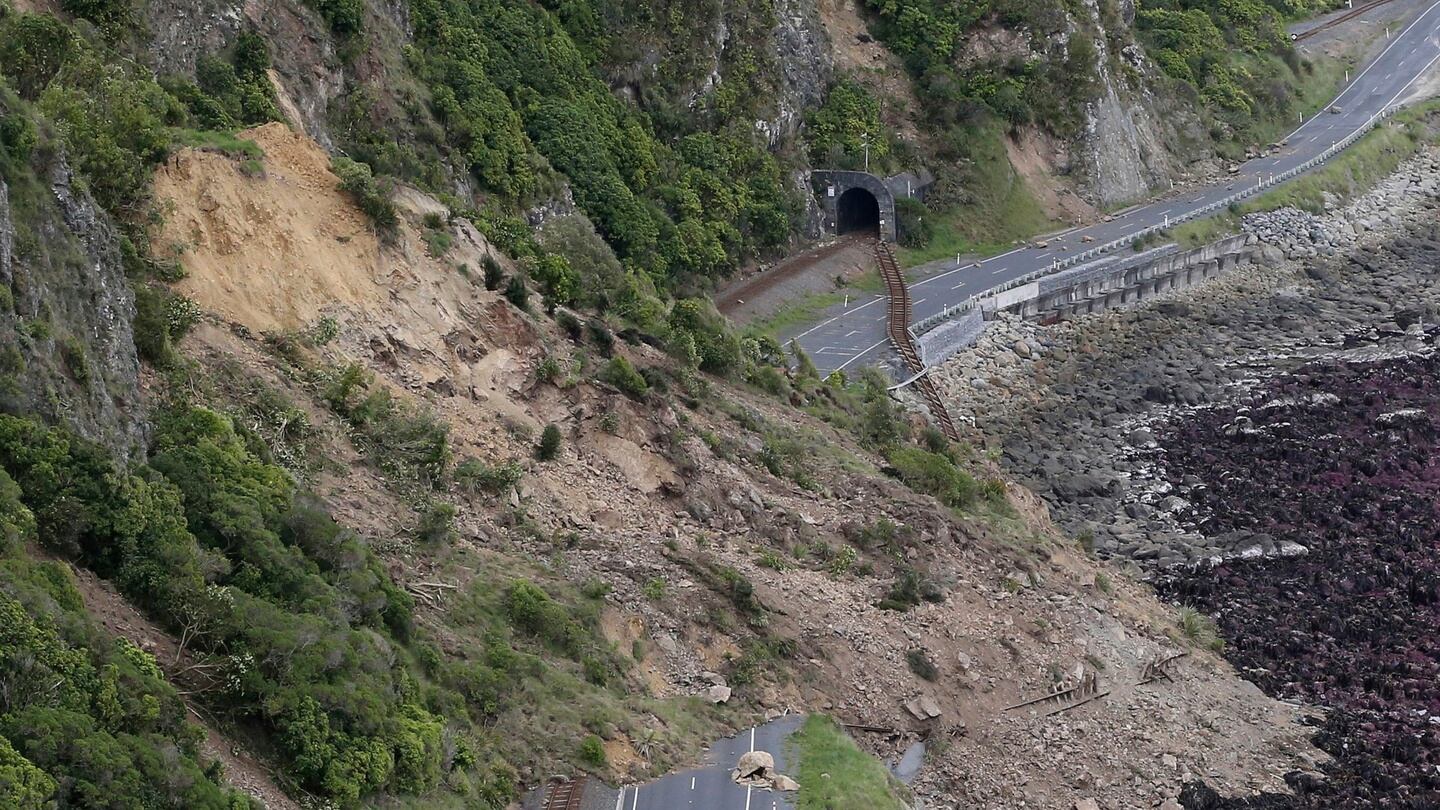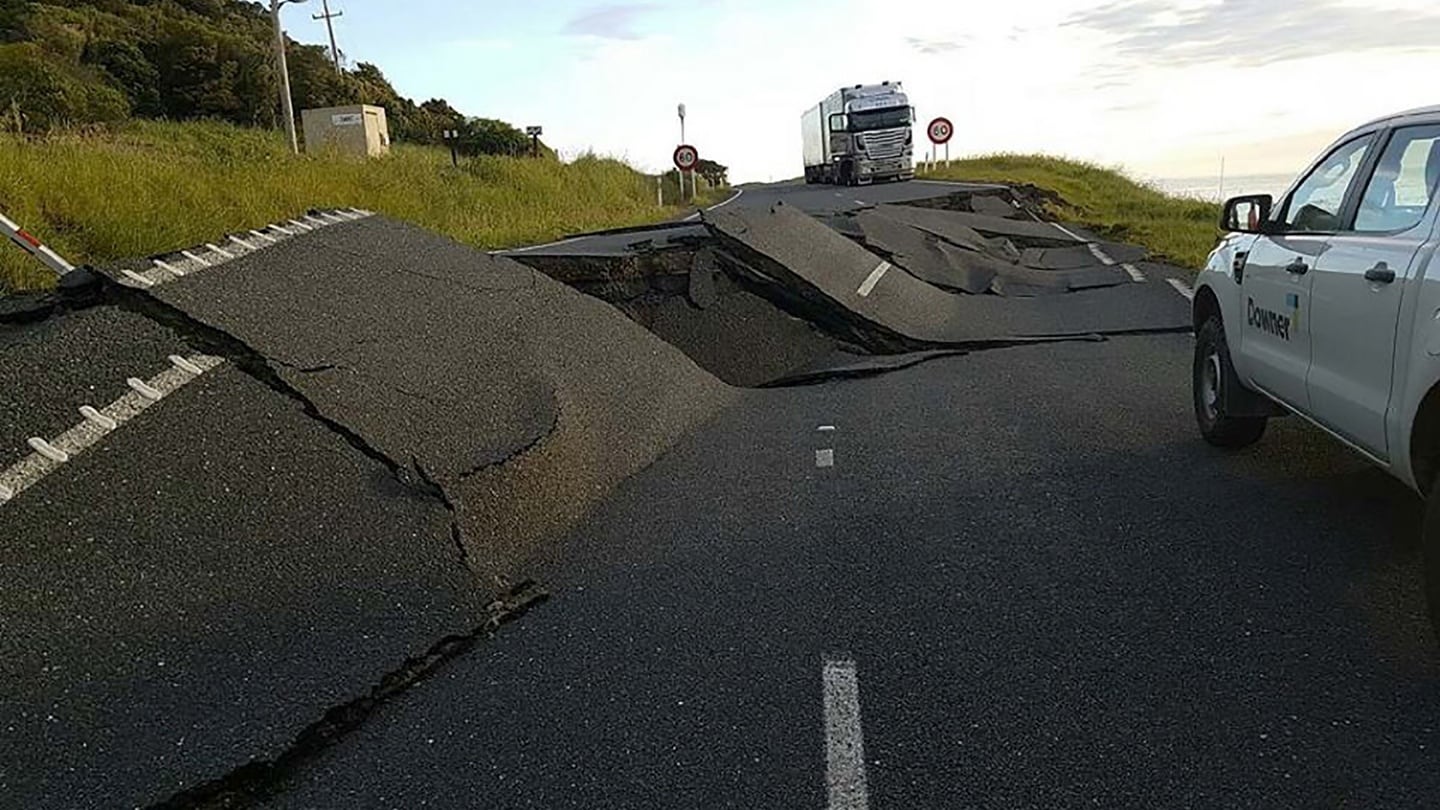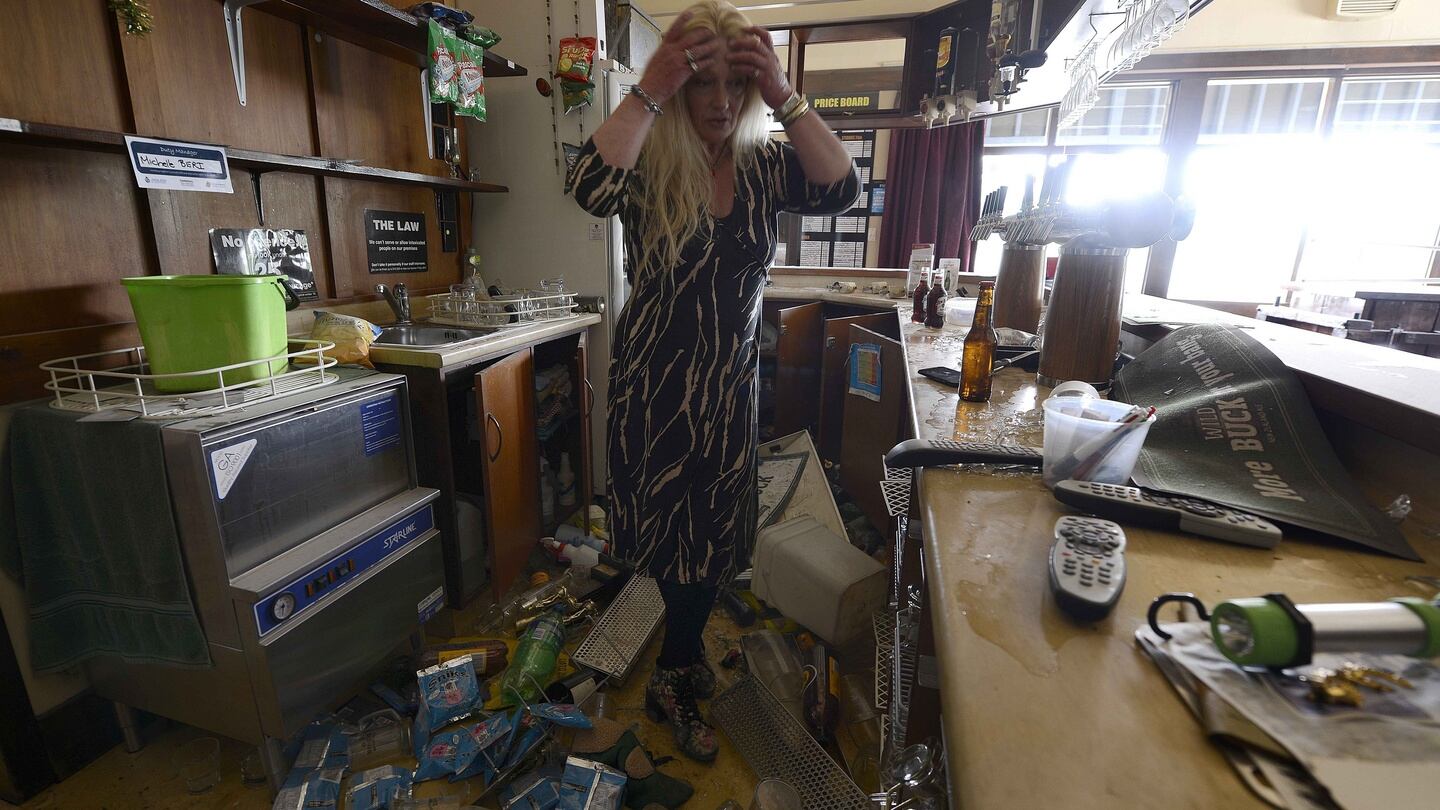New Zealand battled severe storms and violent aftershocks as the country struggled to recover from a devastating earthquake that swallowed roads, twisted railway lines and left towns and cities smashed and deserted.
Tens of thousands of people fled their homes in the middle of the night on Monday to seek higher ground following a tsunami alert covering the entire east coast, although the warnings were later lifted. Across the country, two people have been declared dead.
Prime minister John Key was quoted as saying the damage bill from the earthquake was likely to be at least “a couple of billion dollars”.
0 of 3
“It’s hard to believe that the bill is going to be less than a couple of billion,” he said.
The Red Cross flagged a huge humanitarian challenge in the South Island, saying its volunteers were struggling to reach affected regions. Worst-hit was Kaikoura, a coastal town of about 2,000 people famous for whale watching, which had been almost completely isolated with roads closed and phone lines down.
State of emergency
A state of emergency was declared there, and six people with significant injuries were airlifted out. Police said one person died in Kaikoura and another in Mount Lyford, a nearby ski resort.
Military helicopters and a navy ship were being sent to rescue about 1,000 tourists and hundreds of residents who remain stranded in Kaikoura.
The depth of the devastation has been linked to two significant shakes under the South Island, first a 7.5-magnitude earthquake just after midnight followed by a hefty 6.8-magnitude aftershock during the day.
Fears of secondary disasters emerged after a landslip blocked the South Island’s Clarence river. Water built up for hours before breaching on Monday, sending a torrent downstream that threatened farms and residents.
Malborough’s civil defence force said a “large wall of water” was heading downstream. “Residents urged to go to higher ground immediately,” it said on Twitter. Sixteen rafters and six kayakers who went missing were later declared safe.
Possible flooding
Power was lost in many small South Island towns and parts of the capital, Wellington, which sits at the southern tip of the North Island. Recovery operations were stalled on Monday afternoon as heavy rain and wind moved into the most affected areas, with forecasters warning of possible flooding.
On the night of the disaster, tsunami sirens sounded in the remote seaside villages around Dunedin on the South Island’s southeast coast and emergency services went door to door evacuating residents. The state of emergency was cancelled just after dawn when the tsunami risk was downgraded.
The US Geological Survey said the quake hit near Hanmer Springs, 95km from Christchurch, which is still recovering from the 2011 earthquake that killed 185 people and destroyed many buildings.
On one railway, the line had moved several metres. Photos from the New Zealand defence force showed a entire stretch of rail line that has slipped from out of a tunnel, over a road and on to rocks by the sea.
Mr Key said the quake was the most significant he could remember feeling in Wellington and that his team was clearing up damage in his own offices.
Damage stocktaking
“I know from the Christchurch earthquakes how much it undermines people’s confidence, but I want to reassure people that there will be support there. It was a very significant shock.
“As we have daylight, we can use the military assets we have and others to get a stocktake of the actual damage.”
In Wellington, the quake forced hundreds of tourists on to the streets as hotels were evacuated last night.
Nick Kingstone, a 39-year-old marketing manager living downtown, said the repeated shakes felt like “living on a sleeping dragon who’s waking up”.
Anxiety was high in the capital because there are several fault lines under the city that have not moved for a long time, he said. “When you’re surrounded by quakes and aftershocks it’s hard not to think ‘is this Wellington’s big one?’ Especially as my wife and I have a toddler to care for.”
The aftershocks were “like being on a big cruise ship in big seas, it’s a constant bump and roll”, he said.
Heavy rain and high winds hit the waterfront city by the afternoon. “Let’s hope we don’t have to make shelter in the rain if we need to evacuate tonight,” he said.
Trapped train
There were reports of a train trapped north of Kaikoura, and at least one major building collapsed in the town itself.
St John rescue helicopters have been sent to Kaikoura, loaded with intensive-care medical equipment and extra paramedics to be able to treat patients on the ground, and a number of military helicopters have been sent from Christchurch to assess the damage, re-establish communication and deploy search and rescue teams.
Leigh Smith said in Goose Bay, 15km south of Kaikoura, that “the shaking was massive and violent, the noise was horrendous”. Fearing a tsunami, she spent the night in her car at the top of a nearby hill, feeling continual aftershocks.
After returning to her home, she spent “the day with no power, no phone, no reception, no water, and one hell of a mess to clean up inside”.
Accounts of looting also emerged in the aftermath of the quake. New Zealand’s Newshub website reported that a Christchurch family who fled their home returned hours later to find they had been been burgled.
“They’ve just ransacked the house, it’s horrible, it’s terrible,” said Melissa Mill. [We’re] pretty shaken, pretty disgusted, disheartened.”
On the night of the disaster, tsunami sirens sounded in the remote villages and emergency services went door to door evacuating residents. The state of emergency was cancelled just after dawn when the tsunami risk was downgraded.
Higher ground
After being advised to head to higher ground just after 3am, thousands of Wellingtonians drove or walked from low-lying areas to Mount Victoria, Mount Cook and the hills above Lyall Bay.
Simon Morton and his family were woken by the “super slow roller” quake just after midnight. Morton and his wife, Jo, live in the seaside Wellington suburb of Lyall Bay – just seven to eight metres from the sea.
Morton made the immediate decision to evacuate his family to higher ground and packed the family in his truck and drove them to View Street, nearly 80m above sea level. After 40 minutes and no further serious activity, Morton and his family returned home.
Just as he was getting into bed Morton noticed the tide was the lowest he had ever seen. Fearing tsunamis, his wife said it was “very weird” and the couple made the decision to again evacuate their family.
Morton and his family spent the rest of the night on the hill and were joined by about 100 vehicles packed with evacuees, many of whom had brought pets, coffee and food.
New Zealand lies in the seismically active “Ring of Fire”, a 40,000km arc of volcanoes and oceanic trenches that partly encircles the Pacific Ocean. About 90 per cent of the world’s earthquakes occur within this region.










